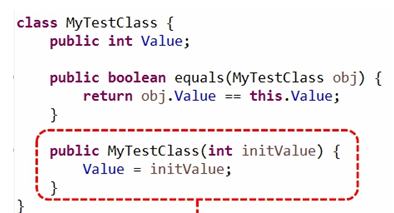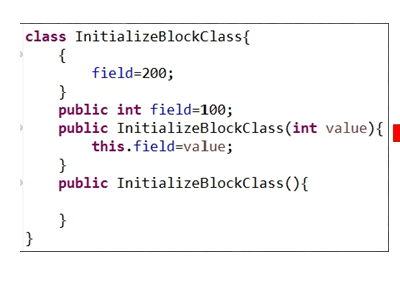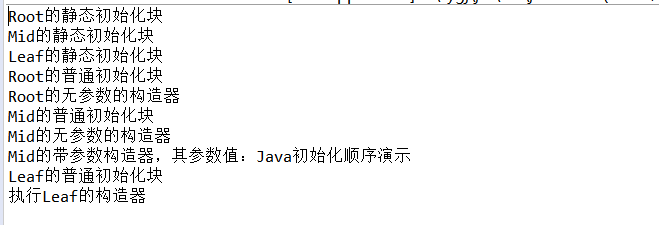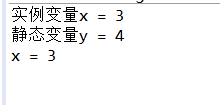1)




public class InitializeBlockDemo {
/**
* @param args
*/
public static void main(String[] args) {
InitializeBlockClass obj=new InitializeBlockClass();
System.out.println(obj.field);
obj=new InitializeBlockClass(300);
System.out.println(obj.field);
}
}
class InitializeBlockClass{
//下面这句在初始化块之前与之后,会影响到field字段的初始值
//public int field=100;
{
field=200;
}
public int field=100;
public InitializeBlockClass(int value){
this.field=value;
}
public InitializeBlockClass(){
}
}

class Root
{
static{
System.out.println("Root的静态初始化块");
}
{
System.out.println("Root的普通初始化块");
}
public Root()
{
System.out.println("Root的无参数的构造器");
}
}
class Mid extends Root
{
static{
System.out.println("Mid的静态初始化块");
}
{
System.out.println("Mid的普通初始化块");
}
public Mid()
{
System.out.println("Mid的无参数的构造器");
}
public Mid(String msg)
{
//通过this调用同一类中重载的构造器
this();
System.out.println("Mid的带参数构造器,其参数值:" + msg);
}
}
class Leaf extends Mid
{
static{
System.out.println("Leaf的静态初始化块");
}
{
System.out.println("Leaf的普通初始化块");
}
public Leaf()
{
//通过super调用父类中有一个字符串参数的构造器
super("Java初始化顺序演示");
System.out.println("执行Leaf的构造器");
}
}
public class TestStaticInitializeBlock
{
public static void main(String[] args)
{
new Leaf();
}
}
运行截图:

public class JingTaiHanShu {
int x = 3;
static int y = 4;
public static void Method()//静态方法
{
System.out.println("实例变量x = " + new JingTaiHanShu().x);/ System.out.println("静态变量y = " + y); }
public static void main(String[] args)
{
JingTaiHanShu.Method();
JingTaiHanShu ex = new JingTaiHanShu();
System.out.println("x = " + ex.x);
}
}
结果截图:


下面这段代码是Integer的valueOf方法的具体实现:
public static Integer valueOf(int i) {
if(i >= -128 && i <= IntegerCache.high)
return IntegerCache.cache[i + 128];
else
return new Integer(i);
}
而其中IntegerCache类的实现为:
private static class IntegerCache {
static final int high;
static final Integer cache[];
static {
final int low = -128;
// high value may be configured by property
int h = 127;
if (integerCacheHighPropValue != null) {
// Use Long.decode here to avoid invoking methods that
// require Integer‘s autoboxing cache to be initialized
int i = Long.decode(integerCacheHighPropValue).intValue();
i = Math.max(i, 127);
// Maximum array size is Integer.MAX_VALUE
h = Math.min(i, Integer.MAX_VALUE - -low);
}
high = h;
cache = new Integer[(high - low) + 1];
int j = low;
for(int k = 0; k < cache.length; k++)
cache[k] = new Integer(j++);
}
private IntegerCache() {}
}
从这2段代码可以看出,在通过valueOf方法创建Integer对象的时候,如果数值在[-128,127]之间,便返回指向IntegerCache.cache中已经存在的对象的引用;否则创建一个新的Integer对象。
上面的代码中i1和i2的数值为100,因此会直接从cache中取已经存在的对象,所以i1和i2指向的是同一个对象,而i3和i4则是分别指向不同的对象。





